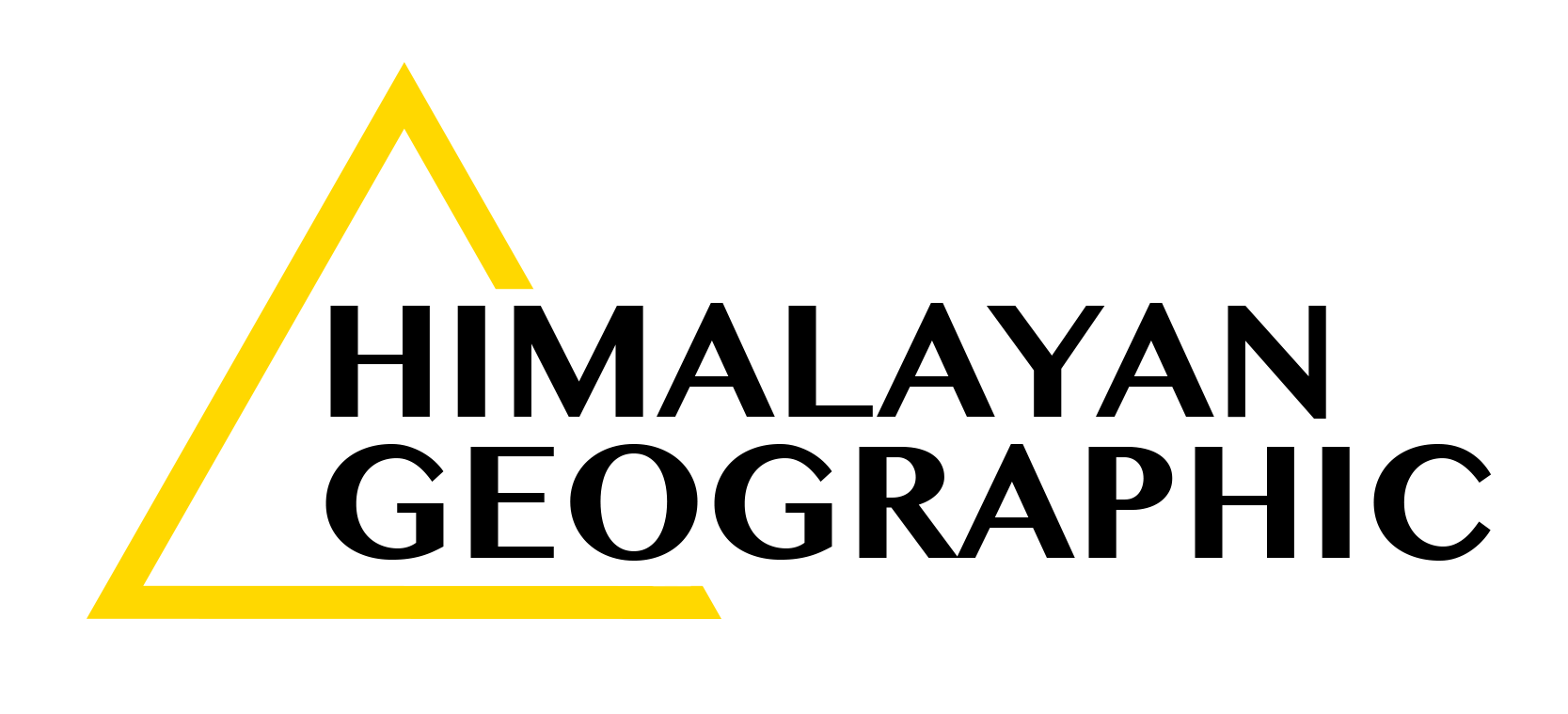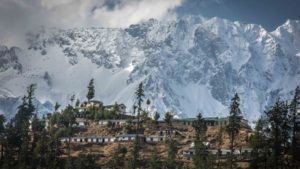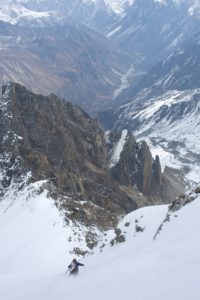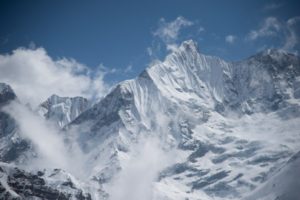Big lines in far western Nepal, a spot that Smithwick says is the future for big mountain powder skiing in the Himalayas.
The storm rolled into the valley warm and wet. After 24 hours of howling winds hammering the tents, it began to clear. It was cold; the storm had passed through right-side-up. Rising early to ski splitter couloirs holding perfect snow below 7000-meter peaks, there were yaks grazing in the fields and not another human soul for miles. This is how Luke Smithwick, a veteran skier of 75 Himalayan expeditions, describes “a good day out” in the world’s highest mountain range.
Smithwick’s skiing roots began much closer to sea level, however, at Beech Mountain—west of Boone, North Carolina. He skied throughout his childhood at Snowshoe and other local southeastern hills until he moved to Boulder to study at the University of Colorado.
Enticed by bigger backcountry lines, he left the slopes of Berthoud Pass for Alaska, working as a snow observer and picking up the ski mountaineering skills that would lead him to embark on his project to ski 500 aesthetic lines that highlight the Himalaya’s potential for great powder skiing. Since starting his goal 10 years ago, Smithwick has ticked off 244 lines of the 500. He expects to finish his project in three years.
Though somewhat under the radar—he claims he doesn’t really know people in the American ski scene—Smithwick, 40, has quietly assembled the most extensive Himalayan ski resume of any American. Working as a guide and with help from sponsors, he has been able to travel and ski extensively in the region. Smithwick says it’s home to some of the best snow he’s ever skied. During Chillai Kalan, the coldest period of the Kashmiri winter, the snow there is around 4 percent density—the same as the famed Wasatch powder.
Curious to know more, we spoke with Smithwick to discuss his project and whether he sees powder skiing in the Himalayas becoming a legitimate destination.
Photo Credit: Keree Smith
Smithwick skiing the first descent of Occam’s Razor in Langtang National Park, Nepal.
What prompted your first Himalayan expedition? What was the lead-up and preparation like for that?
I first went to the Himalayas in 2001; it completely ruined me. After I returned to the U.S., I continued to be exposed to extraordinary places through my own curiosity, yet the Himalayas were always in the back of my mind. I would quietly think, “This is amazing, but it isn’t the Himalayas.” I needed to go back. On that 6 month trip, I simply wanted to experience as much as possible of the massive range. I went into the Annapurnas, Langtang, and then into the western Himalayas of India. I climbed Stok Kangri, a 20,187-foot peak in the Himalayas of Ladakh. That was my first experience with higher altitude in the Himalayas.
Photo Credit: Luke Smithwick
Big dreams, one of Smithwick’s lines in the Himalayas for the HIMALAYA 500. He won’t disclose the name of this peak or its location, yet it is on his lineup for the coming winter. He says it’s in Nepal.
What is it like to be so far from rescue? Have things ever gone bad?
In most of the Himalayas, there are options for a helicopter rescue. However, yes, you really can’t expect rescue support as you would in Chamonix. The Alaska mentality is you do not rely on others, you are self-sustainable and if you get hurt, you get yourself out. If I get injured then I’m riding a yak or a horse out in some places. We go into the mountains with a plan to take care of ourselves.
But I haven’t really had a negative ski experience yet in the Himalayas, and I think it’s because I really keep a conservative approach to skiing and keep in mind how fortunate I am to experience these places. Getting out into wild areas, experiencing people living close to the land, and seeing unique wildlife really make a ski expedition. If we keep that mindset, every day is a gift.
Lots of ski mountaineers seek stable conditions, but you love high speeds and powder snow. Do you have a higher risk tolerance? What makes you different?
When spring season comes and the layers in the snowpack bond together, it’s time to seek out steeper lines and more consequential terrain. Seasons do come when we don’t have deep instabilities, and also periods within a given season have “green light” conditions for tapping the gas pedal and skiing bigger lines at speed. You have to be present there to catch those periods, when I’m away from the Himalayas I’m always concerned I’ll miss a window.
It takes immersing oneself there to catch the big lines in the right conditions, just like anywhere. It also takes an objective mindset, I stared at lines for 9 years in Alaska that I never skied, they simply never came into condition. When those days come, you know you’ve experienced something special, it makes the long days and weeks planning and adjusting and getting ready and failing and trying again worth it.
What is the Himalayan powder skiing community like? Do you have a vision for where it’s going?
Powder skiing in the Himalayas is currently based around the Pir Panjal range (Kashmir, Manali) and a select few areas in the Pakistan Karakoram and Nepal Himalayas. Skiing is steadily growing in Asia, I expect the Himalayas to become a destination. China currently claims to be building 800 ski resorts, Asia is coming onto the world stage for winter sports.
I want skiers to get out and explore the Himalayas for skiing. Make the big approaches, eat apples from local village orchards, learn some words of the local language. Ascend higher and experience the biggest peaks on Earth while skiing high-quality snow among them. Be inspired by the terrain and the potential.
Do you think that kind of mechanized development is plausible in the Himalayas?
Yes, I think that the Himalayas can be a destination for skiing. The Karakoram and the Pir Panjal (Kashmir, Himachal Pradesh) and the Himalayas of Western Nepal are three regions that can be real, viable ski destinations annually.
I think it is not only plausible but important to have select mechanized skiing development in those areas. If we look at the history of skiing in the US, a community grows from lift-served skiing, and skiing culture is sparked by installing a lift. There are interested parties in Nepal, and a gondola and lifts already exist in the Pir Panjal of Pakistan and India.
With such a high personal stake in the region, how would you prefer to see it developed?
I think that a limited amount of commercial development is important for the development of skiing in India, Nepal, and China. Having some ski fields, ski hills with lifts in select places is the way to do that, absolutely. I think it is important for the development of ski culture.
And it depends on what’s most applicable in each area, some regions of the Himalayas are certainly viable for a gondola system similar to Chamonix, while other areas are more privy to touring only and helicopter access. Some valleys can certainly benefit from a ski area.
Smithwick with his ski horses, he says many of the best areas in the Himalayas require big approaches. When he is with horse teams they can get out to the best spots, set up camp, and experience the area as well as their abilities and conditions allow for the given season. Must be present to win. Nepal Himalayas.
And is it important to you to keep large areas pristine and accessible only by foot travel?
Wilderness is vital, and the benefit of ski development has to be approached carefully. Along the same lines, helicopter skiing and other forms of mechanized recreation also need to be approached carefully. We really have to look at what a helicopter brings to a region: interagency response for emergencies, development of rescue programs for mountaineering, skiing, and climbing, and the creation of mountain culture. I think the whole picture needs to be taken into account before we say no to a particular style of skiing across the board.
I think some areas should remain pristine and allow human-powered access only—designated as wilderness areas, just like what we have here in the US. There are heli ski operations in several areas of the Himalayas, I support what they do. Of course, there must be regulation, I do not think we can approach heli skiing like we’ve approached 8000m climbing. There are simply too many climbers during high seasons on the big peaks, but of course, I’m American, and this is my opinion. I’m not in charge of making the regulations for mountain sports development in the Himalayas.
Could you pitch Himalayan skiing to people like us who are hesitant to make the long journey?
I’ve had days when it all came together in western Nepal. Cold storms, massive couloirs. On one trip, we brought our skis to a local school. As they took a break from studying human anatomy that morning we showed them our skis, what they could do in the mountains above their home, and their eyes lit up. Those moments are the best.





